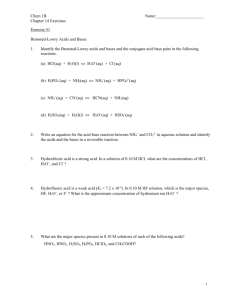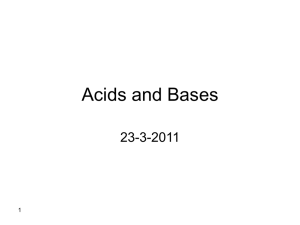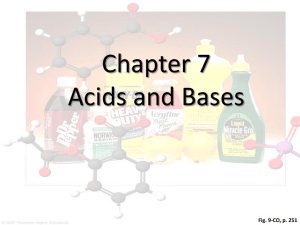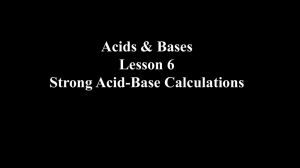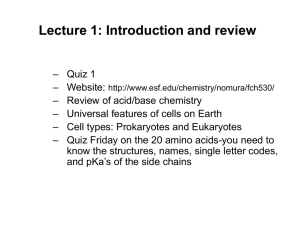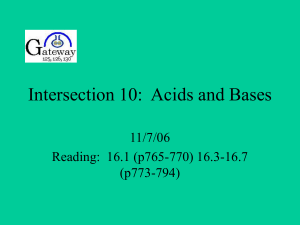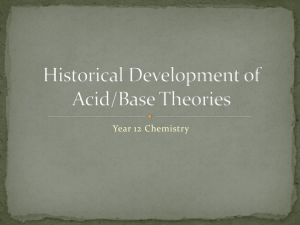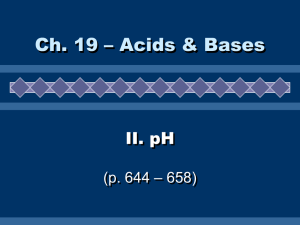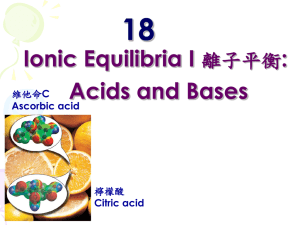ACIDS AND BASES
advertisement
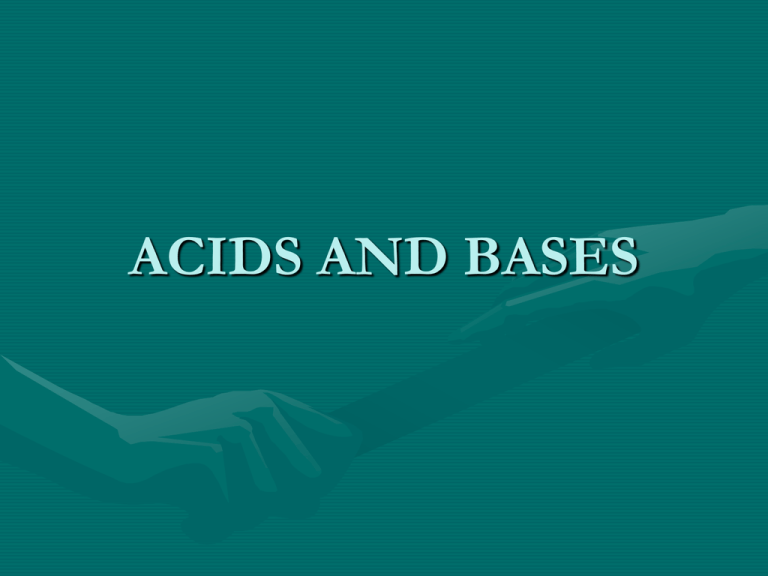
ACIDS AND BASES Acids found around the house • • • • • • • Citric - all citrus fruit Acetic acid – vinegar Carbonic – soda Tannic – tea Lactic- milk, yogurt Sulfuric – car battery Hydrochloric – metal and masonry cleaning • Organic acids are those made by an organism • Mineral acids or inorganic are those that can be made directly at the lab bench, also referred to as industrial acids. 3 Common Industrial Acid 1. Sulfuric ( H2SO4 ) used in most manufacturing Conc 98 % , specific gravity 1.84g/ml dilute = 1 part acid to 5 parts water 2. Hydrochloric (HCl ) masonry and metal cleaning . Conc 36 % , specific gravity 1.19 g/ml dilute = 1 part acid to 4 parts water. 3 Nitric acid ( HNO3 ) Tanning leather, making fertilizer and explosives Conc 70 % Specific gravity 1.42 g/ml dilute = 1 part acid to 3 parts water Demo the three. Acids • Have a sour taste • Affect indicators blue litmus turns red • Acids neutralize bases to make a salt + water • Are electrolytes • Many React with metals to release hydrogen Bases • Have a bitter taste • Affect indicators red litmus turns blue B-B base = blue • Bases neutralize acids to make a salt + water • Are electrolytes • Feel slippery Common bases around the house • • • • • • • Milk of magnesa Mg(OH)2 Draino NaOH House hold Ammonia NH4OH Rolaids Mg(OH)2 / CaCO3 Tums Al(OH)3 ? Milanta , peptobismo Lime CaO for the lawn. Plus H2O makes Ca(OH)2 Arrhenius’s Theory of ionization H+ • H2O + H2O → H3O+ + OH• Water + water yields Hydronium ion + hydroxide ion • If H2O loses an H+ what do you have left? an OH- ion • You get 1.0 x 10-7 H3O+ and 1.0 X 10-7 OH- for every liter of pure water. • Notice that the hydronium and hydroxide ion concentrations are equal, that’s a neutral solution. • When H3O+ > OH- its an acid • When OH- > H3O+ it’s a base • The pH scale is a system to express the “ power of hydronium” . The pH of a neutral solution is 7 The H3O+ concentration is 1.0 X 10 -7 When pH is 3, [H3O+ ] = 1.0 x 10 -3 When pH is 9 [H3O+ ] is 1.0 x 10 -9 [ ] means concentration in moles/liter is • This true so long as the conc is 1.0 times the exponent. • If its not, its math time. • pH = -log( H3O+ ) • What is the pH when[ H3O+ ] is 3.4 x 10-5 ? • - log 3.4 2nd ee – 5 ) enter • You get 4.468521 or 4.47 as the pH • • • • • Other direction pH = 4.47 what is the [H3O+] ? Antilog ( -ph ) = [ H3O+ ] 2nd log - 4.47 ) enter You get 3.4 x 10-5 Back to Arrhenius • • • • In a neutral solution [ H3O+ ] = [ OH- ] Because both equal 1.0 x 10-7 [ H3O+ ] X [ OH- ] = 1.0 x 10-14 Which is a constant, so given either the [H3O+] or the [OH- ] you can solve for the other. • [ H3O+ ] = 1.0 x 10-14 [ OH- ] [ OH- ] = 1.0 x 10-14 [ H3O+ ] pOH = -Log[OH] pH + pOH = 14 if you know either the pH or the pOH, just subtract the one you have from 14 and you have the other one. • Bronsted and Lowery Defined an acid as a proton donor and a base as a proton accepter. There for any substance that contains ionizable hydrogen is an acid. And any negative ion can be a base. HCl + H2O → H3O+ + Cl- in the forward reaction the HCl is the acid and the water is the base. Short form HCl → H+ + Clit is assumed you know the water is required. Conjugate acid base pairs A conjugate base is a base that is produced when an acid gives up a proton. H2SO4 → HSO4- + H+ In this case the HSO4- is the base produced when the H2SO4 gave up the H+ because the bisulfate ion has a negative charge it is a base according to Bronsted/Lowery The only difference between a conjugate acid/base pair is one stinking hydrogen. The acid has it and the base does not. So to determine the conjugate base all you do is subtract one H from the acid and make the resulting ion (-) Do some practice problems Monoprotic acids only have one ionizable Hydrogen , ionizable means that the H can be seperated from the rest of the formula. HCl, HNO3, H C2H3O2 Diprotic acids have two ionizable hydrogens H2SO4 and H2CO3 Triprotic acids have three. Write some ionization equations H3PO4 Amphprotic substances are those that can act as either an acid or a base. The HSO4- ion has an ionizable Hydrogen and a negative charge. So it can give up the H to act as an acid or since its negative it can accept an H to act as a base. These substances are commonly called Buffers. Why? Titration • Acid buret Base buret The Process of reacting a solution of known concentration with one of unknown concentration to determine The concentration of the unknown solution. Titration uses knowledge of balanced equations and mass/mass problems to determine the concentration of an unknown solution. If you know the moles of one reactant, it is possible to calculate the moles of the other from the balanced equation. Then if volume of liquid is also known, molarity can be determined. This sounds hard, but there is an easy way to do it if we convert molarity to normality. Normality / + charge = molarity So Molarity x ( + charge ) = normality .4M H2SO4 .4M x +2 (from the two H’s)=.8N Titration equation Normaliy of acid x volume of acid = Normality of base x volume of base. NaVa = NbVb easy math plug in the three knowns and solve for the missing one. If necessary convert back to molarity Titration curve and equivalence point The equivalence point is the point where you have added an equivalent amount of base to the acid which will just neutralize the acid. The indicator will change color and your done. ( the end point) Strong and weak acids HCl → H+ + Cl- 100 molecules → 100 ions + 100 ions Every molecule of acid ionizes, that a strong acid. HC2H3O2 → H+ + C2H3O2100 molecules → 10 ions + 10 ions + 90 HC2H3O2 that did nothing , that’s a weak acid. Only 10 % of the acid did any thing. Strong and weak bases do the same thing. Acid Anhydrides Non metallic oxides that react with water to form and acid. That’s what causes acid rain. SO2 + H2O → H2SO3 sulfurous acid CO2 + H2O → H2CO3 carbonic acid Basic anhydride Is a metallic oxide that reacts with water to form a base. CaO + H2O → Ca(OH)2 Any of the group I or II elements do the same thing. Naming acids • • • • • Binary acids , contain only two elements HCl Hydro-chloric acid HF Hydro-floric acid HBr Hydro-bromic acid HI Hydro-iodic acid Ternary or Oxy acids • Contain Hydrogen , oxygen and a third element. • • • • per = 1 more (O) HClO4 Root acid HCLO3 1 less (O) HClO2 2 Less (O) HClO perchloric acid chloric acid chlorous acid hypochlorous Other Root acids • If you understand the previous system, and Know the names and formulas of the following root acids, (memorize them) naming oxy-acids is easy. • H2SO4 - sulfuric acid • HNO3 - nitric acid • H2CO3 - carbonic acid • H3PO4 - phosphoric acid • HCLO3 - chloric acid Making acid solutions from the concentrated liquid • Question : How much concentrated sulfuric acid is needed to make 400ml of .3M H2SO4 ? • Using molarity x fw x Liters = grams • .3 M x 98 x .400 L = 11.7 grams H2SO4 so how many ml of the conc liquid do we need? Concentrated H2SO4 is 98 % acid and has a specific gravity of 1.84g/ml • That means each ml of the acid has a mass of 1.84 grams. 1.84 gram x .98 1.80 grams dry weight per ml From above we needed 11.7 grams dry weight 11.7 grams x 1 ml = 1.80 grams 6.6 ml of conc H2SO4 Place 6.6 ml of conc acid in a graduated cylinder and add enough water to bring the total volume to 400ml and you are done. I forgot about Lewis acids Work in progress not done yet • .


